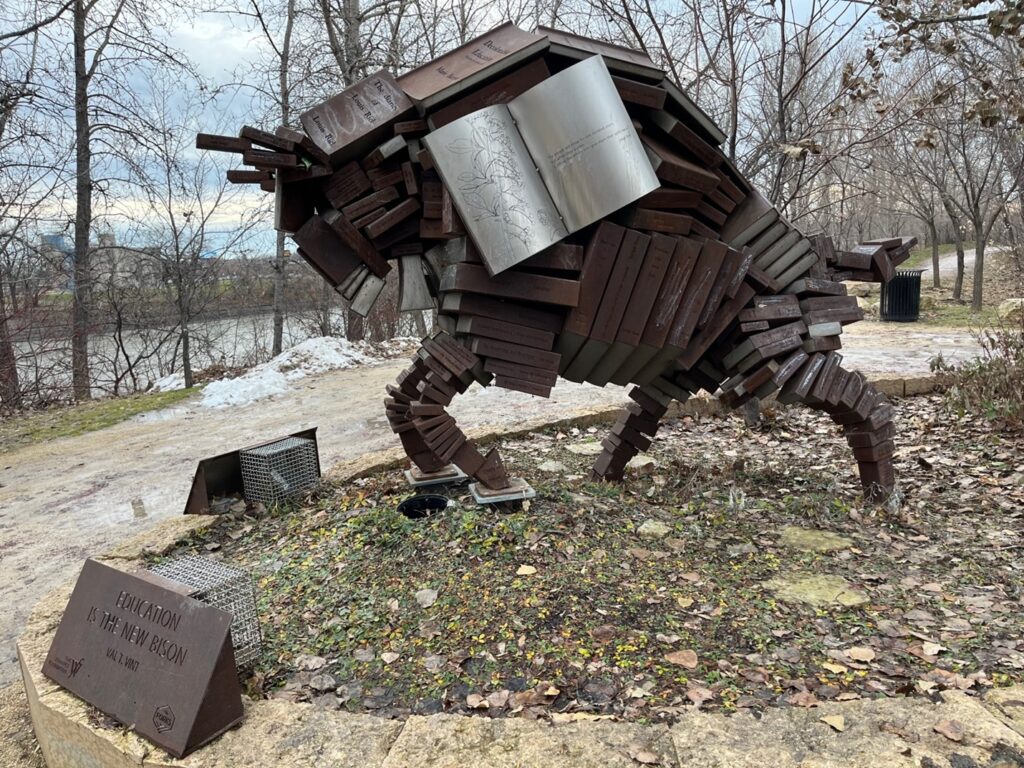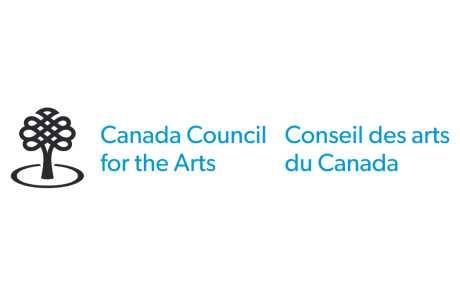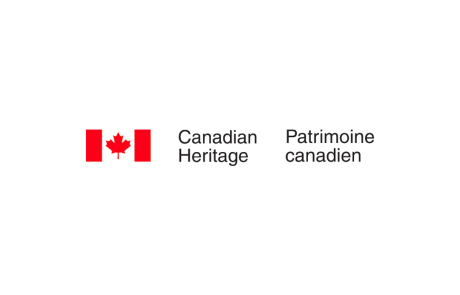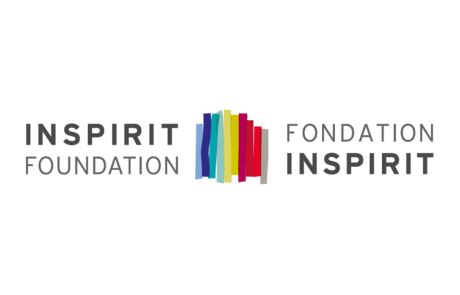‘Chi-kishkayhitamihk Si Te Li Neu Biizon’ (Education is the New Bison) sculpture, photo provided by Val Vint
A Response to ‘Chi-kishkayhitamihk Si Te Li Neu Biizon’ (Education is the New Bison)
by KC Adams
Tansi! Capipaminat Mikisew Iskwew nitisinakason. (1) I have a meandering story to tell that eventually leads to why Val Vint’s Chi-kishkayhitamihk Si Te Li Neu Biizon (Education is the New Bison) is my favourite piece of public art. As I traverse through this world, there are moments that etch themselves upon my soul, altering how I look at the world.
One of these moments occurred in 2003 when I visited the UNESCO World Heritage Site, Head Smashed in Buffalo Jump, at the foothills near the Rocky Mountains in Alberta. It is a museum dedicated to the recorded history of Indigenous nations gathering and working together for bison hunts. This sacred site is a testament to Indigenous peoples’ strength and ingenuity and stands as a sanctuary of remembrance, where the echoes of Indigenous kinship resound through time. Perched upon the face of a cliff, the museum invites visitors to embark on a vertical journey, ascending through its chambers to the summit, where the panorama unfolds, revealing the valley’s magic. With the howling winds and the optical illusion of the cliffs blending into the ground below, you can understand how the Indigenous ancestors were able to harvest bison by luring them off the rock face.
However, it wasn’t solely the external landscape that stirred my imagination; it was also the museum’s contents, paying homage to the bison’s revered bounty. Exhibited were the various technologies derived from the bison’s body: the bladder transformed into a flask, the horn into a drinking vessel, the bones into scraping tools, the sinew into rope, and the fur into bedding, etc. Each part of the bison served a purpose, reflecting its integral role in the survival of the Indigenous ancestors. Our guide emphasized the bison’s significance, not just as a source of sustenance but as a revered teacher whose lessons endure. Reflecting on this profound experience, I developed a newfound respect for the bison, thanks to the recorded histories of the ancient ones displayed in the museum through song, dance, and ceremony. It was clear that the bison emerged as a unifying force between nations, weaving together the fabric of community and a source of knowledge, imparting resilience for generations to come.
Richard B. Williams, who is an Ogala Lakota who is an advocate from the Ogala Lakota Nation writes of these relatives:
“It gave its life so Indians could live. The buffalo’s generosity provided Indians with food and shelter. Indian people modelled the buffalo’s generosity, and it became fundamental to the economy of the American Indian.” (2)
My story fast forwards to 2017 when I was in collaboration with Val Vint (Métis) and Jaimie Issac (Anishinaabe). We were tasked to design sections of a peninsula at the south point of the Winnipeg Forks, aptly named Niizhoziibean, which translates to “two rivers” in Anishinaabemowin, mirroring its location at the convergence of the Red and Assiniboine rivers. Selected from a pool of submissions, Jaimie, Val, and I embarked on the task of envisioning a beautiful, inclusive, and culturally resonant space for the territory. Our first responsibility involved creating a public art monument adjacent to the Red River, alongside the Norwood Bridge. Our collaboration flowed seamlessly, mirroring the fluidity of the surrounding waters, culminating in the creation of Niimaamaa, a towering twenty-five-foot metal sculpture depicting a kneeling pregnant woman, symbolizing Mother Earth and serving as a poignant reminder of our collective duty to protect our planet. Guided by principles of respect, kindness, and humility, our efforts garnered the admiration of the funding body Winnipeg Foundation. In recognition of our work, in 2019, they extended the opportunity for each of us to design a public sculpture to be showcased at the Forks.

‘Niimaamaa’ sculpture by KC Adams, Jaimie Isaac, and Val T. Vint, Photo provided by The Forks
Val was the first to design, and I was awestruck when I beheld her sketch for Chi-kishkayhitamihk Si Te Li Neu Biizon, a twelve-foot sculpture adorned with two hundred steel replicas of books and films authored by Indigenous writers(3). Reflecting on my time at Head Smashed In Buffalo Jump, where the bison’s parts held invaluable knowledge for our ancestors’ survival, I realized the profound significance of Val’s design. While traditional bison harvesting practices have waned, the wisdom they impart remains important. Through education, encapsulated within the books, we access the wealth of Indigenous knowledge and ancestral memory, akin to the sustenance provided by the bison in ages past. As Val eloquently states, “Education enables us to grasp our history and the challenges confronting our society.”(4) Each book within the sculpture embodies a facet of this ancestral wisdom, preserving the essence of our heritage while guiding future generations. Education serves as the conduit through which we nourish our minds and spirits, fostering a deeper understanding of our place in the universe and the responsibilities it entails. As my story concludes, Chi-kishkayhitamihk Si Te Li Neu Biizon emerges not only as a captivating sight but also as a treasury of wisdom echoing the spirit of the bison and all this creature/relative had to teach us. So now you know why it is my favourite public artwork, and I encourage anyone who is traversing through Winnipeg to stop by this magnificent sculpture and choose a book to read; I guarantee you will learn something!
1. In Inninew (Cree) Hello! My name is Flying Overhead in Circles Eagle Woman.
2. John (Fire) Lame Deer and Richard Erdoes, Lame Deer Seeker of Visions: Life of a Sioux Medicine Man (Touchstone Publishing, 1982)
3. Full list of Books & Films referenced in Chi-kishkayhitamihk Si Te Li Neu Biizon’ (Education is the New Bison). *There is also a small selection of books by ally settlers.
4. Vint, Val. Education is the New Bison. The Forks, Winnipeg, 2020. Commissioned by The Winnipeg Foundation. Public remarks made during the unveiling of the sculpture, which emphasizes the role of education in understanding history and societal challenges. [Accessed October 24, 2024].
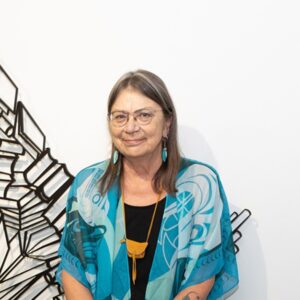
Val Vint was born in Winnipegosis, Manitoba, where the most meaningful part of her childhood was spent in the bush, chasing foxes and pelicans with her Grandfather, a conservation officer. Drawing from a diverse background encompassing photography, ceramics, painting, engineering, design, theatre, performance art, music, travel, and collaboration with other indigenous peoples, Val’s cultural heritage instills a sense of license to explore all forms of art.
Belonging to the Métis community, known for their fierce independence and versatile culture, Val’s work reflects this spirit, manifesting in a diverse range of mediums. Over the past four decades, her life’s focus has been a blend of power engineering, artistic expression, cultural enrichment, community programming, and personal art practice. Val has conducted workshops across Manitoba, Scotland, and Latin America, contributing to initiatives such as the Indigenous Designers Cooperative and serving as a program coordinator at Art City, projects deeply cherished.
Beyond familial narrative and professional endeavours, Val actively advocates for her community through involvement in women’s organizations and drumming. For 16 years, she has been a member of the Buffalo Gals Drum Circle at the North End Women’s Center. As a multimedia artist, Val’s repertoire spans willow-work, fabric arts, ceramics, traditional tanning methods, watercolour, oil, acrylic, sculpture, public art, acting, photography, video, writing, traditional singing and drumming, and beadwork, reflecting her rich and multifaceted creative journey.
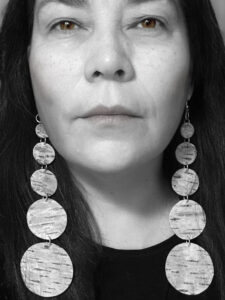 KC Adams is of Anishinaabe, Ininnew and British descent, registered to Fisher River Cree Nation and calls Winnipeg, Manitoba her home. Adams is of the Bear clan and a member of the Shoal Lake Midewin Grand Medicine Society. Adams graduated with a Bachelor of Fine Arts in Studio Art from Concordia University and a Master of Arts in Cultural Studies, Curatorial Stream from the University of Winnipeg. She is a relational maker, a creator who infuses Indigenous knowledge such as cultural, spiritual, land, and familial teachings in everything she makes. Adams is also an educator, mentor, activist, community member, experimental archeologist and author. Her career has spanned over the course of twenty-six years with a multitude of solo and group exhibitions and residencies, three biennales, including the PHOTOQUAI: Biennale des images du monde in Paris, France. Her work has been exhibited throughout Turtle Island and collected by institutions worldwide. Twenty pieces from the Cyborg Hybrid Series are in the permanent collection of the National Art Gallery in Ottawa, the museé du qua Branly, Paris, France, and the National Museum of the American Indian in New York, USA and four trees from Birch Bark Ltd are in the Canadian Consulate of Australia, NSW collection. Adams was awarded the Winnipeg Arts Council’s Making A Mark Award, Canada’s Senate 150 medal, the Ohpinamake Award in Indigenous Art and the Quill & Quire’s 2019 Books of the Year.
KC Adams is of Anishinaabe, Ininnew and British descent, registered to Fisher River Cree Nation and calls Winnipeg, Manitoba her home. Adams is of the Bear clan and a member of the Shoal Lake Midewin Grand Medicine Society. Adams graduated with a Bachelor of Fine Arts in Studio Art from Concordia University and a Master of Arts in Cultural Studies, Curatorial Stream from the University of Winnipeg. She is a relational maker, a creator who infuses Indigenous knowledge such as cultural, spiritual, land, and familial teachings in everything she makes. Adams is also an educator, mentor, activist, community member, experimental archeologist and author. Her career has spanned over the course of twenty-six years with a multitude of solo and group exhibitions and residencies, three biennales, including the PHOTOQUAI: Biennale des images du monde in Paris, France. Her work has been exhibited throughout Turtle Island and collected by institutions worldwide. Twenty pieces from the Cyborg Hybrid Series are in the permanent collection of the National Art Gallery in Ottawa, the museé du qua Branly, Paris, France, and the National Museum of the American Indian in New York, USA and four trees from Birch Bark Ltd are in the Canadian Consulate of Australia, NSW collection. Adams was awarded the Winnipeg Arts Council’s Making A Mark Award, Canada’s Senate 150 medal, the Ohpinamake Award in Indigenous Art and the Quill & Quire’s 2019 Books of the Year.

